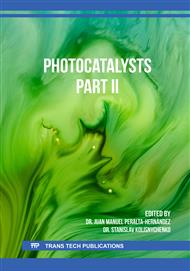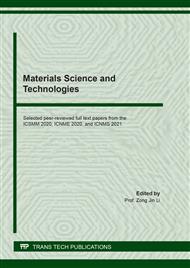[1]
DA Yaseen, M. Scholz, Textile dye wastewater characteristics and constituents of synthetic effluents: a critical review, Int. J. Environ. Sci. Technol. 16 (2019) 1193–1226.
DOI: 10.1007/s13762-018-2130-z
Google Scholar
[2]
R. Javaid, U.Y. Qazi, Catalytic Oxidation Process for the Degradation of Synthetic Dyes: An Overview, Int. J. Environ. Res. Public Health. 16 (2019) (2066).
DOI: 10.3390/ijerph16112066
Google Scholar
[3]
CR Holkar, AJ Jadhav, D. V. Pinjari, N.M. Mahamuni, A.B. Pandit, A critical review on textile wastewater treatments: Possible approaches, J. Environ. Manage. 182 (2016) 351–366.
DOI: 10.1016/j.jenvman.2016.07.090
Google Scholar
[4]
I. Sirés, E. Brillas, M.A. Oturan, M.A. Rodrigo, M. Panizza, Electrochemical advanced oxidation processes: Today and tomorrow. A review, Environ. Sci. Pollut. Res. 21 (2014) 8336–8367.
DOI: 10.1007/s11356-014-2783-1
Google Scholar
[5]
C.A. Martínez-Huitle, M.A. Rodrigo, I. Sirés, O. Scialdone, Single and Coupled Electrochemical Processes and Reactors for the Abatement of Organic Water Pollutants: A Critical Review, Chem. Rev. 115 (2015) 13362–13407.
DOI: 10.1021/acs.chemrev.5b00361
Google Scholar
[6]
F.C. Moreira, R.A.R. Boaventura, E. Brillas, V.J.P. Vilar, Electrochemical advanced oxidation processes: A review on their application to synthetic and real wastewaters, Appl. Catal. B Environ. 202 (2017) 217–261.
DOI: 10.1016/j.apcatb.2016.08.037
Google Scholar
[7]
S. Garcia-Segura, J.D. Ocon, M.N. Chong, Electrochemical oxidation remediation of real wastewater effluents — A review, Process Saf. Environ. Prot. 113 (2018) 48–67.
DOI: 10.1016/j.psep.2017.09.014
Google Scholar
[8]
S. Garcia-Segura, E. Brillas, Applied photoelectrocatalysis on the degradation of organic pollutants in wastewaters, J. Photochem. Photobiol. C Photochem. Rev. 31 (2017) 1–35.
DOI: 10.1016/j.jphotochemrev.2017.01.005
Google Scholar
[9]
E. Kusmierek, Semiconductor Electrode Materials Applied in Photoelectrocatalytic Wastewater Treatment—an Overview, Catalysts. 10 (2020) 439.
DOI: 10.3390/catal10040439
Google Scholar
[10]
M. Ge, C. Cao, J. Huang, S. Li, Z. Chen, K.Q. Zhang, S.S. Al-Deyab, Y. Lai, A review of one-dimensional TiO2 nanostructured materials for environmental and energy applications, J. Mater. Chem. A. 4 (2016) 6772–6801.
DOI: 10.1039/c5ta09323f
Google Scholar
[11]
F.X. Xiao, J. Miao, H.B. Tao, S.F. Hung, H.Y. Wang, H. Bin Yang, J. Chen, R. Chen, B. Liu, One-dimensional hybrid nanostructures for heterogeneous photocatalysis and photoelectrocatalysis, Small. 11 (2015) 2115–2131.
DOI: 10.1002/smll.201402420
Google Scholar
[12]
H. Park, Y. Park, W. Kim, W. Choi, Surface modification of TiO2 photocatalyst for environmental applications, J. Photochem. Photobiol. C Photochem. Rev. 15 (2013) 1–20.
Google Scholar
[13]
M. Pelaez, N.T. Nolan, S.C. Pillai, M.K. Seery, P. Falaras, A.G. Kontos, P.S.M. Dunlop, J.W.J. Hamilton, J.A. Byrne, K. O'Shea, M.H. Entezari, DD. Dionysiou, A review on the visible light active titanium dioxide photocatalysts for environmental applications, Appl. Catal. B Environ. 125 (2012) 331–349.
DOI: 10.1016/j.apcatb.2012.05.036
Google Scholar
[14]
A. El Ruby Mohamed, S. Rohani, Modified TiO2 nanotube arrays (TNTAs): Progressive strategies towards visible light responsive photoanode, a review, Energy Environ. Sci. 4 (2011) 1065–1086.
DOI: 10.1039/c0ee00488j
Google Scholar
[15]
R. Daghrir, P. Drogui, D. Robert, Modified TiO2 for environmental photocatalytic applications: A review, Ind. Eng. Chem. Res. 52 (2013) 3581–3599.
DOI: 10.1021/ie303468t
Google Scholar
[16]
M.G. Peleyeju, O.A. Arotiba, Recent trend in visible-light photoelectrocatalytic systems for degradation of organic contaminants in water/wastewater, Environ. Sci. Water Res. Technol. 4 (2018) 1389–1411.
DOI: 10.1039/c8ew00276b
Google Scholar
[17]
R. Shwetharani, M. Sakar, C.A.N. Fernando, V. Binas, R.G. Balakrishna, Recent advances and strategies to tailor the energy levels, active sites and electron mobility in titania and its doped/composite analogues for hydrogen evolution in sunlight, Catal. Sci. Technol. 9 (2019) 12–46.
DOI: 10.1039/c8cy01395k
Google Scholar
[18]
YC Nah, I. Paramasivam, P. Schmuki, Doped TiO2 and TiO2 nanotubes: Synthesis and applications, ChemPhysChem. 11 (2010) 2698–2713.
DOI: 10.1002/cphc.201000276
Google Scholar
[19]
E.C.R. Lopez, J.D. Ocon, J.V.D. Perez, Synthesis of Silver-Doped Titanium Dioxide Nanotubes by Single-Step Anodization for Enhanced Photodegradation of Acid Orange 52, Mater. Sci. Forum. 950 (2019) 149–153.
DOI: 10.4028/www.scientific.net/msf.950.149
Google Scholar
[20]
E.C.R. Lopez, V.A.F. Cleofe, R.Y.A. Cañal, K.F.P. Boado, J.V.D. Perez, Photoelectrocatalytic Degradation of CI Basic Blue 9 under UV Light Using Silver-Doped Titanium Dioxide Nanotubes, Key Eng. Mater. 831 (2020) 132–141.
DOI: 10.4028/www.scientific.net/kem.831.132
Google Scholar
[21]
E.C.R. Lopez, V.A.F. Cleofe, R.Y.A. Cañal, K.F.P. Boado, J.V.D. Perez, Highly-Organized One-Dimensional Copper-Doped Titanium Dioxide Nanotubes for Photoelectrocatalytic Degradation of Acid Orange 52, Key Eng. Mater. 801 (2019) 285–291.
DOI: 10.4028/www.scientific.net/kem.801.285
Google Scholar
[22]
E.C.R. Lopez, N.E.B. Saputil, L.A. Loza, F.F.G. Camiguing, M.J.L. Mopon, J.V.D. Perez, Iron/Sulfur Co-Doped Titanium Dioxide Nanotubes: Optimization of the Photoelectrocatalytic Degradation of Phenol Red under Visible Light, Key Eng. Mater. 847 (2020) 95–101.
DOI: 10.4028/www.scientific.net/kem.847.95
Google Scholar
[23]
K.M. Reza, A. Kurny, F. Gulshan, Parameters affecting the photocatalytic degradation of dyes using TiO2: a review, Appl. Water Sci. 7 (2017) 1569–1578.
DOI: 10.1007/s13201-015-0367-y
Google Scholar
[24]
Y. Wang, R. Zhang, J. Li, L. Li, S. Lin, First-principles study on transition metal-doped anatase TiO2, Nanoscale Res. Lett. 9 (2014) 46.
DOI: 10.1186/1556-276x-9-46
Google Scholar
[25]
Q. Meng, T. Wang, E. Liu, X. Ma, Q. Ge, J. Gong, Understanding electronic and optical properties of anatase TiO2 photocatalysts co-doped with nitrogen and transition metals, Phys. Chem. Chem. Phys. 15 (2013) 9549–9561.
DOI: 10.1039/c3cp51476e
Google Scholar
[26]
X. Hou, X. Liu, J. Han, H. Liu, J. Yao, D. Li, L. Wang, B. Liao, J. Li, R. Zhang, Enhanced photoelectrocatalytic degradation of organic pollutants using TiO2 nanotubes implanted with nitrogen ions, J. Mater. Sci. 55 (2020) 5843–5860.
DOI: 10.1007/s10853-020-04461-5
Google Scholar
[27]
G.G. Bessegato, L.C. De Almeida, S.L.C. Ferreira, M.V.B. Zanoni, Experimental design as a tool for parameter optimization of photoelectrocatalytic degradation of a textile dye, J. Environ. Chem. Eng. 7 (2019) 103264.
DOI: 10.1016/j.jece.2019.103264
Google Scholar
[28]
G.G. Bessegato, J.C. Cardoso, M.V.B. Zanoni, Enhanced photoelectrocatalytic degradation of an acid dye with boron-doped TiO2 nanotube anodes, Catal. Today. 240 (2015) 100–106.
DOI: 10.1016/j.cattod.2014.03.073
Google Scholar



